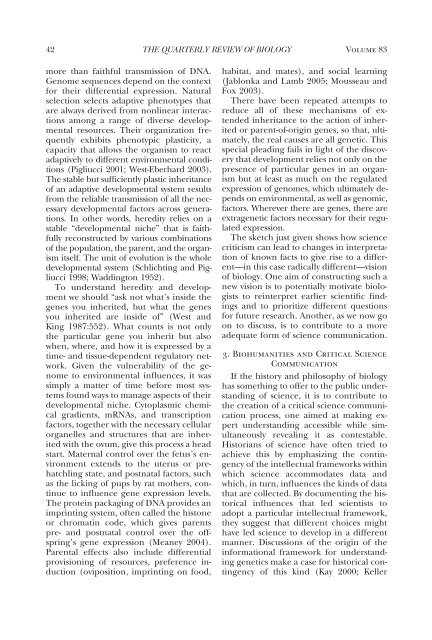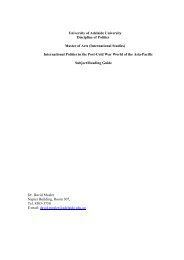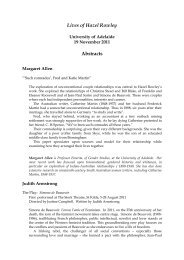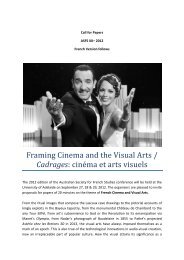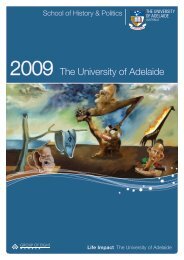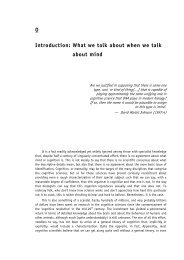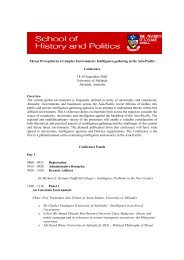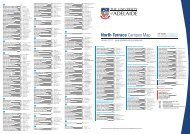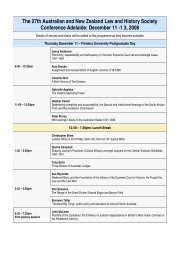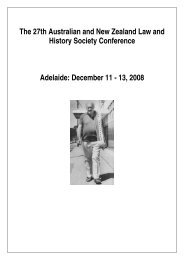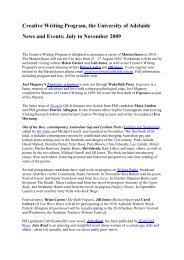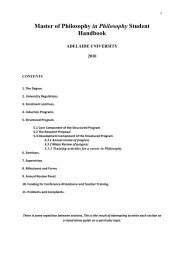Biohumanities - Paul Griffiths - Representing Genes
Biohumanities - Paul Griffiths - Representing Genes
Biohumanities - Paul Griffiths - Representing Genes
Create successful ePaper yourself
Turn your PDF publications into a flip-book with our unique Google optimized e-Paper software.
42 THE QUARTERLY REVIEW OF BIOLOGY<br />
Volume 83<br />
more than faithful transmission of DNA.<br />
Genome sequences depend on the context<br />
for their differential expression. Natural<br />
selection selects adaptive phenotypes that<br />
are always derived from nonlinear interactions<br />
among a range of diverse developmental<br />
resources. Their organization frequently<br />
exhibits phenotypic plasticity, a<br />
capacity that allows the organism to react<br />
adaptively to different environmental conditions<br />
(Pigliucci 2001; West-Eberhard 2003).<br />
The stable but sufficiently plastic inheritance<br />
of an adaptive developmental system results<br />
from the reliable transmission of all the necessary<br />
developmental factors across generations.<br />
In other words, heredity relies on a<br />
stable “developmental niche” that is faithfully<br />
reconstructed by various combinations<br />
of the population, the parent, and the organism<br />
itself. The unit of evolution is the whole<br />
developmental system (Schlichting and Pigliucci<br />
1998; Waddington 1952).<br />
To understand heredity and development<br />
we should “ask not what’s inside the<br />
genes you inherited, but what the genes<br />
you inherited are inside of” (West and<br />
King 1987:552). What counts is not only<br />
the particular gene you inherit but also<br />
when, where, and how it is expressed by a<br />
time- and tissue-dependent regulatory network.<br />
Given the vulnerability of the genome<br />
to environmental influences, it was<br />
simply a matter of time before most systems<br />
found ways to manage aspects of their<br />
developmental niche. Cytoplasmic chemical<br />
gradients, mRNAs, and transcription<br />
factors, together with the necessary cellular<br />
organelles and structures that are inherited<br />
with the ovum, give this process a head<br />
start. Maternal control over the fetus’s environment<br />
extends to the uterus or prehatchling<br />
state, and postnatal factors, such<br />
as the licking of pups by rat mothers, continue<br />
to influence gene expression levels.<br />
The protein packaging of DNA provides an<br />
imprinting system, often called the histone<br />
or chromatin code, which gives parents<br />
pre- and postnatal control over the offspring’s<br />
gene expression (Meaney 2004).<br />
Parental effects also include differential<br />
provisioning of resources, preference induction<br />
(oviposition, imprinting on food,<br />
habitat, and mates), and social learning<br />
(Jablonka and Lamb 2005; Mousseau and<br />
Fox 2003).<br />
There have been repeated attempts to<br />
reduce all of these mechanisms of extended<br />
inheritance to the action of inherited<br />
or parent-of-origin genes, so that, ultimately,<br />
the real causes are all genetic. This<br />
special pleading fails in light of the discovery<br />
that development relies not only on the<br />
presence of particular genes in an organism<br />
but at least as much on the regulated<br />
expression of genomes, which ultimately depends<br />
on environmental, as well as genomic,<br />
factors. Wherever there are genes, there are<br />
extragenetic factors necessary for their regulated<br />
expression.<br />
The sketch just given shows how science<br />
criticism can lead to changes in interpretation<br />
of known facts to give rise to a different—in<br />
this case radically different—vision<br />
of biology. One aim of constructing such a<br />
new vision is to potentially motivate biologists<br />
to reinterpret earlier scientific findings<br />
and to prioritize different questions<br />
for future research. Another, as we now go<br />
on to discuss, is to contribute to a more<br />
adequate form of science communication.<br />
3. <strong>Biohumanities</strong> and Critical Science<br />
Communication<br />
If the history and philosophy of biology<br />
has something to offer to the public understanding<br />
of science, it is to contribute to<br />
the creation of a critical science communication<br />
process, one aimed at making expert<br />
understanding accessible while simultaneously<br />
revealing it as contestable.<br />
Historians of science have often tried to<br />
achieve this by emphasizing the contingency<br />
of the intellectual frameworks within<br />
which science accommodates data and<br />
which, in turn, influences the kinds of data<br />
that are collected. By documenting the historical<br />
influences that led scientists to<br />
adopt a particular intellectual framework,<br />
they suggest that different choices might<br />
have led science to develop in a different<br />
manner. Discussions of the origin of the<br />
informational framework for understanding<br />
genetics make a case for historical contingency<br />
of this kind (Kay 2000; Keller


